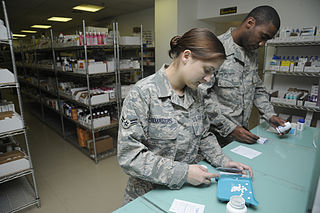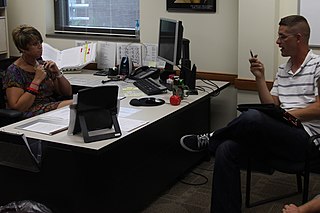
The Monetary Authority of Singapore or (MAS), is the central bank and financial regulatory authority of Singapore. It administers the various statutes pertaining to money, banking, insurance, securities and the financial sector in general, as well as currency issuance and manages the foreign-exchange reserves. It was established in 1971 to act as the banker to and as a financial agent of the Government of Singapore. The body is duly accountable to the Parliament of Singapore through the Minister-in-charge, who is also the Incumbent Chairman of the central bank.
The Association of American Medical Colleges (AAMC) is a nonprofit organization based in Washington, D.C. that was established in 1876. It represents medical schools, teaching hospitals, and academic and scientific societies, while providing services to its member institutions that include data from medical, education, and health studies, as well as consulting. The AAMC administers the Medical College Admission Test and operates the American Medical College Application Service and the Electronic Residency Application Service. Along with the American Medical Association (AMA), the AAMC co-sponsors the Liaison Committee on Medical Education (LCME), the accrediting body for all U.S. MD-granting medical education programs.

A pharmacy technician performs pharmacy-related functions. Training, certification, licensing, and actual practice of pharmacy technicians varies not only worldwide but in some countries regionally as well as by employer.
Close Brothers Group plc is a UK merchant banking group which provides lending, takes deposits, manages wealth and trades in securities. The company is listed on the London Stock Exchange and is a constituent of the FTSE 250 Index.

The American Counseling Association (ACA) is a membership organization representing licensed professional counselors (LPCs), counseling students, and other counseling professionals in the United States. It is the world's largest association exclusively representing professional counselors.

Career counseling is a type of advice-giving and support provided by career counselors to their clients, to help the clients manage their journey through life, learning and work changes (career). This includes career exploration, making career choices, managing career changes, lifelong career development and dealing with other career-related issues. There is no agreed definition of the role of a career or employment counsellor worldwide, mainly due to conceptual, cultural and linguistic differences. However, the terminology of 'career counseling' typically denotes a professional intervention which is conducted either one-on-one or in a small group. Career counseling is related to other types of counseling. What unites all types of professional counseling is the role of practitioners, who combine giving advice on their topic of expertise with counseling techniques that support clients in making complex decisions and facing difficult situations.
The Financial Industry Regulatory Authority (FINRA) is a private American corporation that acts as a self-regulatory organization (SRO) that regulates member brokerage firms and exchange markets. FINRA is the successor to the National Association of Securities Dealers, Inc. (NASD) as well as to the member regulation, enforcement, and arbitration operations of the New York Stock Exchange. The U.S. government agency that acts as the ultimate regulator of the U.S. securities industry, including FINRA, is the U.S. Securities and Exchange Commission (SEC).

The National Association of Corporate Directors (NACD) is an independent, not-for-profit, section 501(c)(3) founded in 1977 and headquartered in Arlington, Virginia. NACD's membership includes more than 1,750 corporate boards as well as several thousand individual members, for a total of more than 24,000 members. Membership is open to individual board members and corporate boards of public, private, and nonprofit organizations from both the United States and overseas.
Nacha, originally the National Automated Clearinghouse Association, manages the ACH Network, the backbone for the electronic movement of money and data in the United States, and is an association for the payments industry. The ACH Network serves as a network for direct consumer, business, and government payments, and annually facilitates billions of payments such as Direct Deposit and Direct Payment. The ACH Network is governed by the Nacha Operating Rules.
Pathward Financial, Inc. is a U.S.-based banking and financial services company. It adopted its current name in 2022 after its parent, Meta Financial Group, sold the "Meta" trademark to Meta Platforms.
The NAI (Network Advertising Initiative) is an industry trade group founded in 2000 that develops self-regulatory standards for online advertising. Advertising networks created the organization in response to concerns from the Federal Trade Commission and consumer groups that online advertising — particularly targeted or behavioral advertising — harmed user privacy. The NAI seeks to provide self-regulatory guidelines for participating networks and opt-out technologies for consumers in order to maintain the value of online advertising while protecting consumer privacy. Membership in the NAI has fluctuated greatly over time, and both the organization and its self-regulatory system have been criticized for being ineffective in promoting privacy.
Dwolla is a United States-only fintech company that provides businesses with a connection to the ACH Network or RTP Network.
Financial Executives International (FEI) is a member-service–oriented organization based in Morristown, New Jersey, for senior-level financial at companies of all types. FEI operates a separate nonprofit foundation: Financial Education & Research Foundation (FERF), which acts as an impartial financial resource for members and Foundation supporters.
Vocalink is a payment systems company headquartered in the United Kingdom, created in 2007 from the merger between Voca and LINK. It designs, builds and operates the UK payments infrastructure, which underpins the provision of the Bacs payment system and the UK ATM LINK switching platform covering 65,000 ATMs and the UK Faster Payments systems.
Circle is a peer-to-peer payments technology company that now manages stablecoin USDC, a cryptocurrency the value of which is pegged to the U.S. dollar. It was founded by Jeremy Allaire and Sean Neville in October 2013. Circle is headquartered in Boston, Massachusetts. USDC, the second largest stablecoin worldwide, is designed to hold at or near a stable price of $1. The majority of its stablecoin collateral is held in short-term U.S. government securities.
The STEM pipeline is the educational pathway for students in the fields of science, technology, engineering, and mathematics (STEM). The start and end of this STEM pipeline are disputed, but it is often considered to begin in early education and extend into graduation or an adult career in STEM.
Alibaba Cloud, also known as Aliyun, is a cloud computing company, a subsidiary of Alibaba Group. Alibaba Cloud provides cloud computing services to online businesses and Alibaba's own e-commerce ecosystem. Its international operations are registered and headquartered in Singapore.

PayU is a Netherlands-based payment service provider to online merchants. The company was founded in 2002, and is headquartered in Hoofddorp. It allows online businesses to accept and process payments through payment methods that can be integrated with web and mobile applications. As of 2018, the service is available in 17 countries. The firm is owned by the Naspers Group, which also owns a stake in one of its sister companies, Tencent.

An automated clearing house (ACH) is a computer-based electronic network for processing transactions, usually domestic low value payments, between participating financial institutions. It may support both credit transfers and direct debits. The ACH system is designed to process batches of payments containing numerous transactions, and it charges fees low enough to encourage its use for low-value payments.
Crypto.com is a cryptocurrency exchange company based in Singapore that offers various financial services, including an app, exchange, and non-custodial DeFi wallet, NFT marketplace, and direct payment service in cryptocurrency. As of June 2023, the company reportedly had 80 million customers and 4,000 employees. The exchange issues its own exchange token named Cronos (CRO).


















